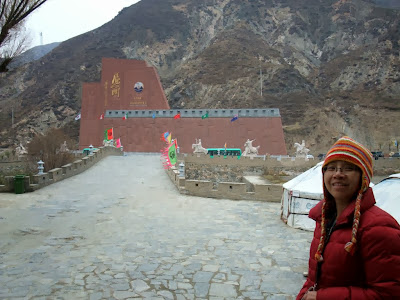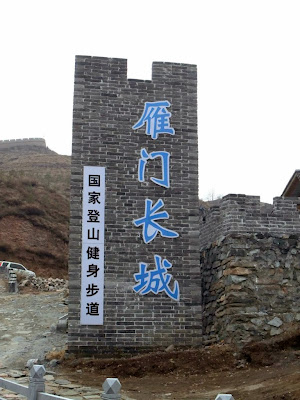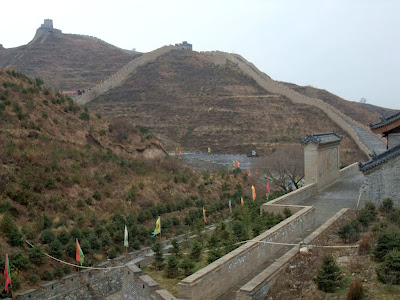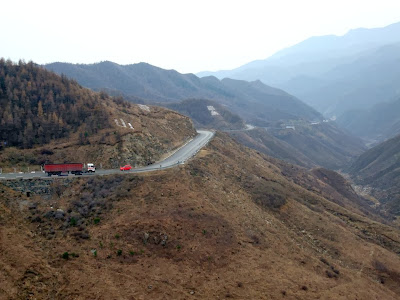
The Pass of Yanmen-guan (雁门关) was regarded as the principal of the nine important passes in ancient times of China due to its strategic importance in position. The Pass located at the ridge of Gouzhou Mountain north west of Daixian (代县), where even the wild goose faced challenge to fly through. This was how the name derived from as Yanmen means the door for wild goose. Yanmen Pass was first built in Tang Dynasty (618-907) at the site established since Warring Period (475-221BC)to defense against the northern nomads. It was then called Xiting-guan but the fortress eventually became dormant and abandon. In year 1374 during Ming Dynasty, the fortress was reconstructed along with The Great Wall at the east side of its existing spot. The present remains and military relics were all from Ming Dynasty.



We did not manage to climb to the old remains of Yanmen-guan but visited the newly completed replica just to understand how an ancient pass work to fight against invaders. This replica of Yanmen-guan was built in year 2009 to recall the imposing magnificence of this most important fortress in the Great Wall of China at its peak time. The investment spent on the 106 projects that extended from its original north Gate, included the great wall, arch gate, pagoda, buildings and commercial street, summed up to as much as 380 million rmb.



The green buses at front place were the free carriage for the tourists to proceed to the site after buying an entry ticket which costs about RMB100.00.


A modern new entrance.


White horse-riding statues of Patriotic General Yangye and all his family members were displayed in line at the entrance site.



The models of Ming Great Wall and Mongolian Tents were also set at entrance site.



Main Gate.




Cultural Village


Baotu Spring (豹突泉) had nourished the soldiers at Yanmen-guan for 1000 over years. The roaring water emerged from the flat ground surface as if a monster and ran towards the northern frontier site before flowing into Sanggan River (桑干河) . It never dried up in drought and never over flowed during wet season.





A commercial street was one of the Yanmen Replica Project.




The commercial street though touristic but not bustling.




Did it look like an ancient wooden troop carriage?



Most of the mountainous area has this kind of red sticky earth.



Enter into Wengcheng (瓮城), the North Alley.




A view of the 21st century built Great Wall!



All historic site at Shanxi has a Temple for the Three Kingdom Hero, General Guan-yu, so is Yanmen-Guan.


Models of weapons and fighting equipments that were used in battles at olden times.






The arch gate of Guan-yu Temple.



The north alley was restored in year 2010 to its original state as Ming structure with a stone plague inscribed with Yanmen-guan and two couplets with hand writing of Fu-shan, a calligrapher of Ming Dynasty.



The inscription of characters Yanmen-guan and two couplets were believed to be the true relics.



Tianxian (天险) was the East Gate, which means super danger and risky.




“中华第一关 The first and principal pass of China in ancient times” were written high top at the main structure.



Yanmen-Guan is the site where many famous historical battles took place.


Replica of the West Gate: Dili Gate (地利门) and Pavilion Ningbian-lou (宁边楼).



Garrison Office was built in this structure.



The model of heavy metal ancient doors.




An outstanding Ancestral temple complex.



The Ancestral Temple Complex was originally established in year 1506 in memorial of Li-mu (李牧), a Great General of Warring Period.



Besides General Li-mu, the newly built temple also worship Ming General Yang-ye and his family members as they were the heroes from Shanxi.



Halls for generals and heroes from different era.




The Ancestral Temple at its original, was quite a large scheme complex. It occupied nearly a land area of 3200 sq. meter with half of it built with structures. The complex was destroyed by Japanese invaders during 2nd World War.



Many tourists paid respect to those patriotic heroes and generals from the past 2600 years with offering of incense.


Ancestral Temple Complex here is only a site of scenery with no historical value.



The cave dwellings at the yard south of the Ancestral Temple Complex were for visiting guests of Yanmen-guan in the past.





There were all together eleven cave dwellings.


Some had received historic celebrities like Chinese famous Poet Li-bai and Ming Calligrapher Fu-shan etc



It was said that the 5 princess who had intermarriage with northern nomads also stopped by and accommodated at the dwelling caves before crossed over the frontier.



According to history, cave dwellings also were the accommodation for 22 Emperors when they came to Yanmen-Guan. And it was also the resting place for Chairman Mao-zhetong when he came here in 20th century.


A scenic sight viewed from cave dwellings yard.









It was indeed a great job in the past to built The Yanmen-Guan at such a splendid ridge and a great project, though is entirely meant for touristic purposes, to imitate this ancient military relics at the same site.



Three Gates were built in accordance to the original Yanmen-Guan. Yanmen Pass was at the north and was the smaller. The other two were East Gate Tian-xian and West Gate, Dili.



Panoramic view of the 21st century built Yanmen Pass.






Pagoda and watch tower were all newly constructed structures.






Climbing the 21st century built Great Wall and enjoyed the same scenic sights that had maintained from the past.




Structures were new but story was old.




It needs stamina too to climb all these newly in-stored stone steps.





We decided not to explore into the remains of ancient military relics and remains of Yanmen Guan by this way as information in hand was incomplete. It could take long hours and might not be too safe for only two of us.


Imagine, how great was the job to stretch over the mountains a line of inner great wall started from here.


To explore the original remains of Yanman-guan, began from here.



A watch point of Gouzhou Mountain ranges.



Magnificent scenery.



Splendid ranges!


The mountain route that cut through the ranges.



The whole route has 18 turning curves. Vehicle ascending up to the peak at No. 7th curve would start to descend down the hill. It was a wonderful and interesting journey.



Figure of Yang-ye standing by the mountain route.



The welcoming banner of Yanmen-guan.



No comments:
Post a Comment